38 Brilliant Examples of eCommerce Personalization



eCommerce personalization is one tough nut to crack:
And this is why we wrote this post - to help you harness the power of personalization - smartly.
We’ll talk about:
38 eCommerce personalization examples that converts into more sales
Why should you use personalization for your eCommerce website?
Benefits of eCommerce personalization
How to collect data for eCommerce personalization?
eCommerce personalization is a working list of on-site improvements like:
✅ showing individualized product recommendations on product pages
✅ offering custom discounts and exclusive offers on emails
✅ remembering previous shopping habits (like browsing history, sizing, and other personal information)
As simple as it sounds, it actually all starts by looking at user behavior on your website (like which pages get drop-offs, which buttons get clicked, etc.).
Not incorporating personalization has cost businesses over $756 billion – here are just a few more reasons why you should be using personalization:
Want to gain the benefits that come from eCommerce personalization?
Consider adding personalized copy, product recommendations, and pop-up offers to your website – need inspiration?
Let’s dive in!
The answer to “how to personalize eCommerce shopping experience” starts right at the homepage.
Saks Fifth Avenue shows how, with one of the best AI personalization examples we’ve seen in 2025, by creating dynamic recommendations on their homepage based on purchase and product page history:
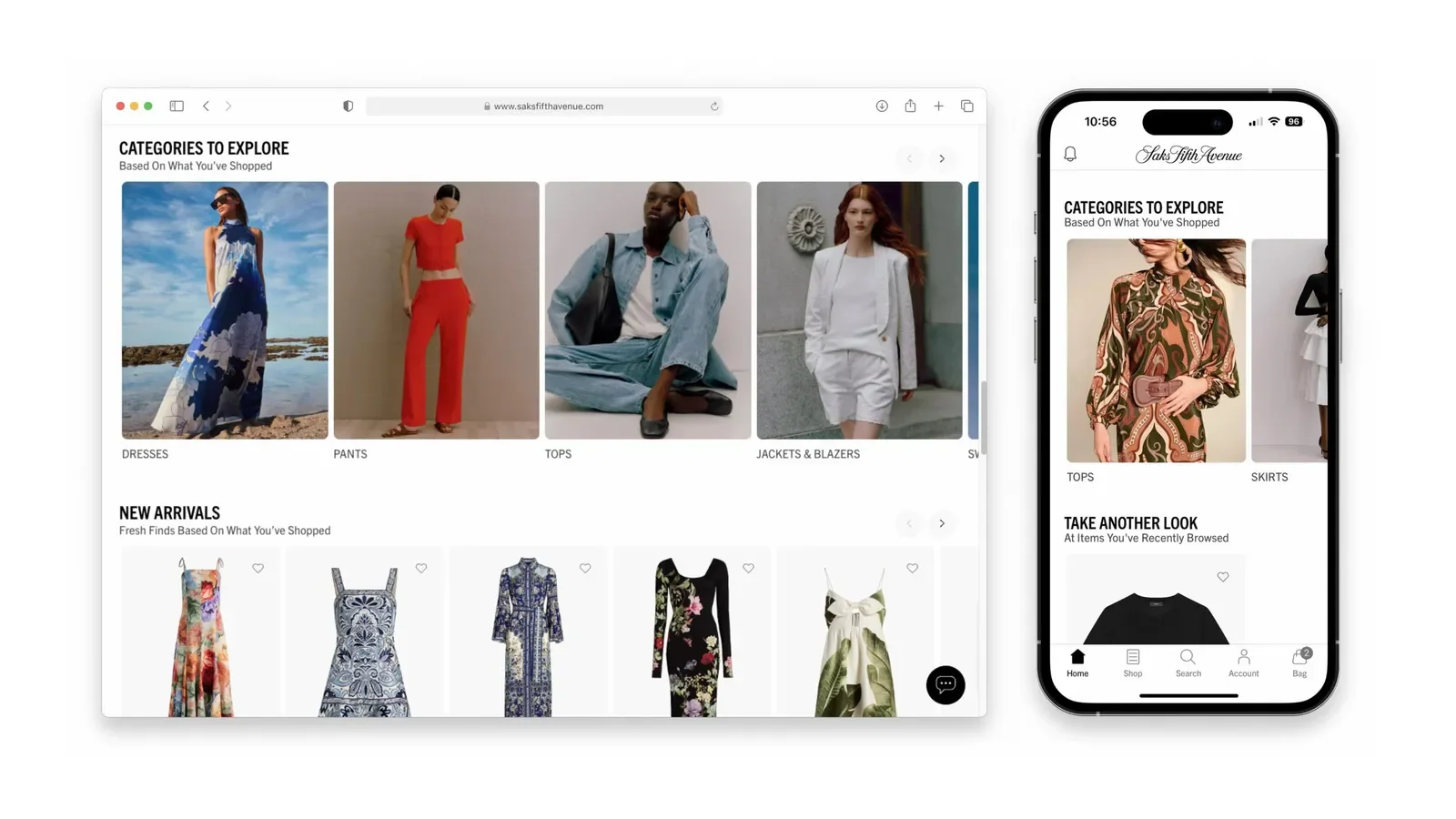
With a 10% bump in conversion rate and 7% jump in revenue per visitor, the genius of this eCommerce personalization technique is in how the entire homepage is built on dynamic content blocks.
Each block changes to match the individual shopper’s taste and preferences. Note how the “categories to explore” section changes by a shopper’s account history in the above example.
Pro Tip: When running personalized recommendations based on shopping behavior, always have a fallback mechanism (for example, you can base change recommendations by browsing behavior in real time, which is exactly what Saks does, when they don’t have access to account history):
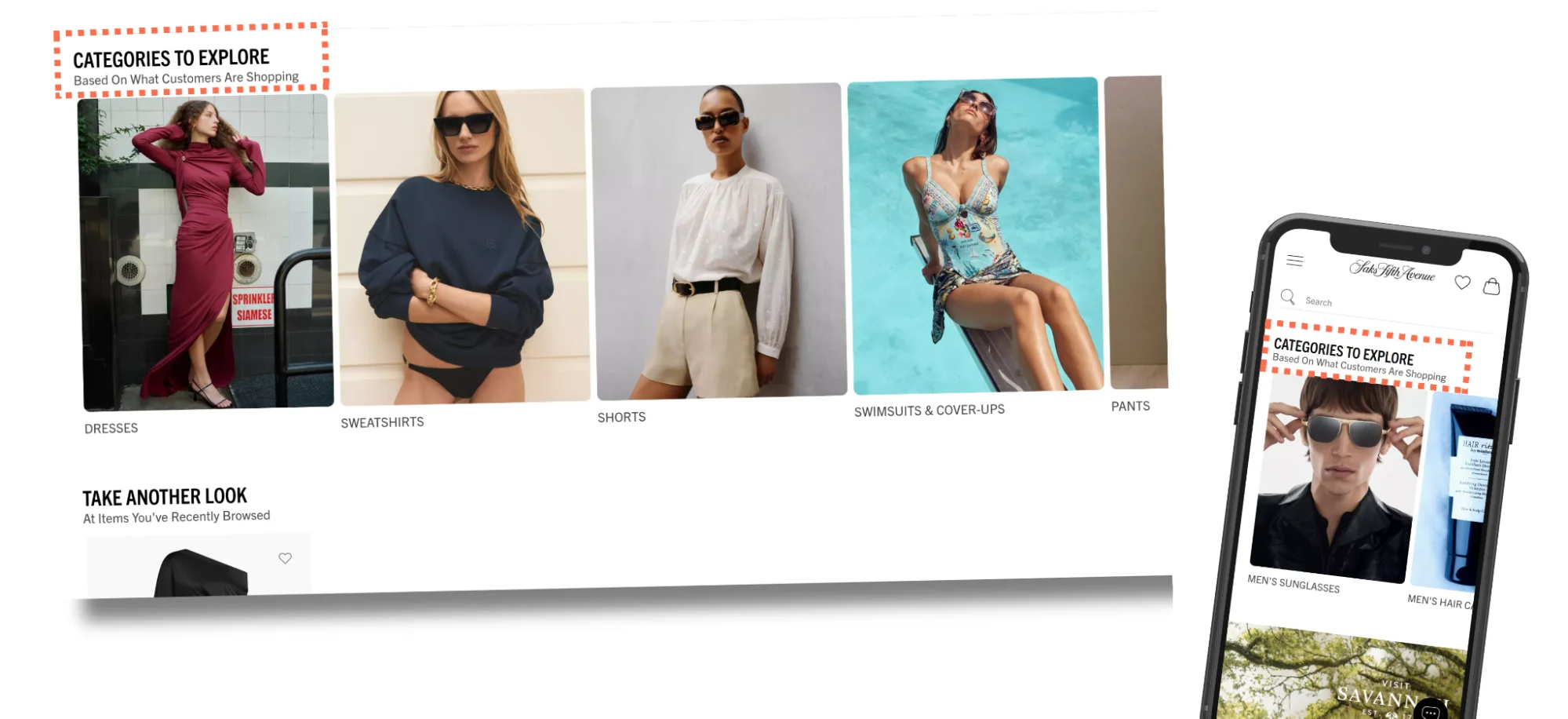
Most eCommerce stores can easily overwhelm shoppers, because they are all images and text. This is exactly where this brilliant next-gen eCommerce personalization comes in – Bio True’s AI agent uses audio and video to offer guided selling and aid in product discovery:
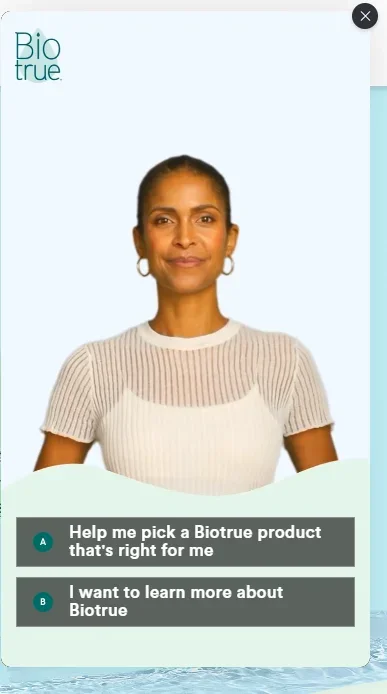
The best part about this personalization idea is that you can pre-set shopping paths to collect data and lead shoppers to discover products. It doesn’t stop there; you can also onboard shoppers with personalized deals and lead them right to checkout.
Pro Tip: You can also use AI shopping agents to:
Also read: Using AI for Conversion Rate Optimization: 7 Proven Strategies for eCommerce Stores
The biggest conversion blockers eCommerce stores face: the lack of touch and feel.
This is exactly why Augmented Reality (AR) personalization is booming right now – it allows shoppers to do everything, from viewing furniture in their own space to trying on glasses. Moscot’s try-on personalization example shows how shoppers can try on multiple styles by just uploading an image:

The best part of this personalization is that it offers eCommerce customization and personalization in one go, which can help cement purchase decisions and reduce return rates.
Pro Tip: You can use AI-powered augmented reality personalization to detect sizes – for example, you can detect skin shades or face sizes based on photos uploaded.
Who says quizzes have to be only about discovering products? This quiz personalization example from Golden Goose shows how to move shoppers from the decision to the retention stage, just by instilling confidence in sizing, and asking questions based on real-time user data like body shape, weight, age:
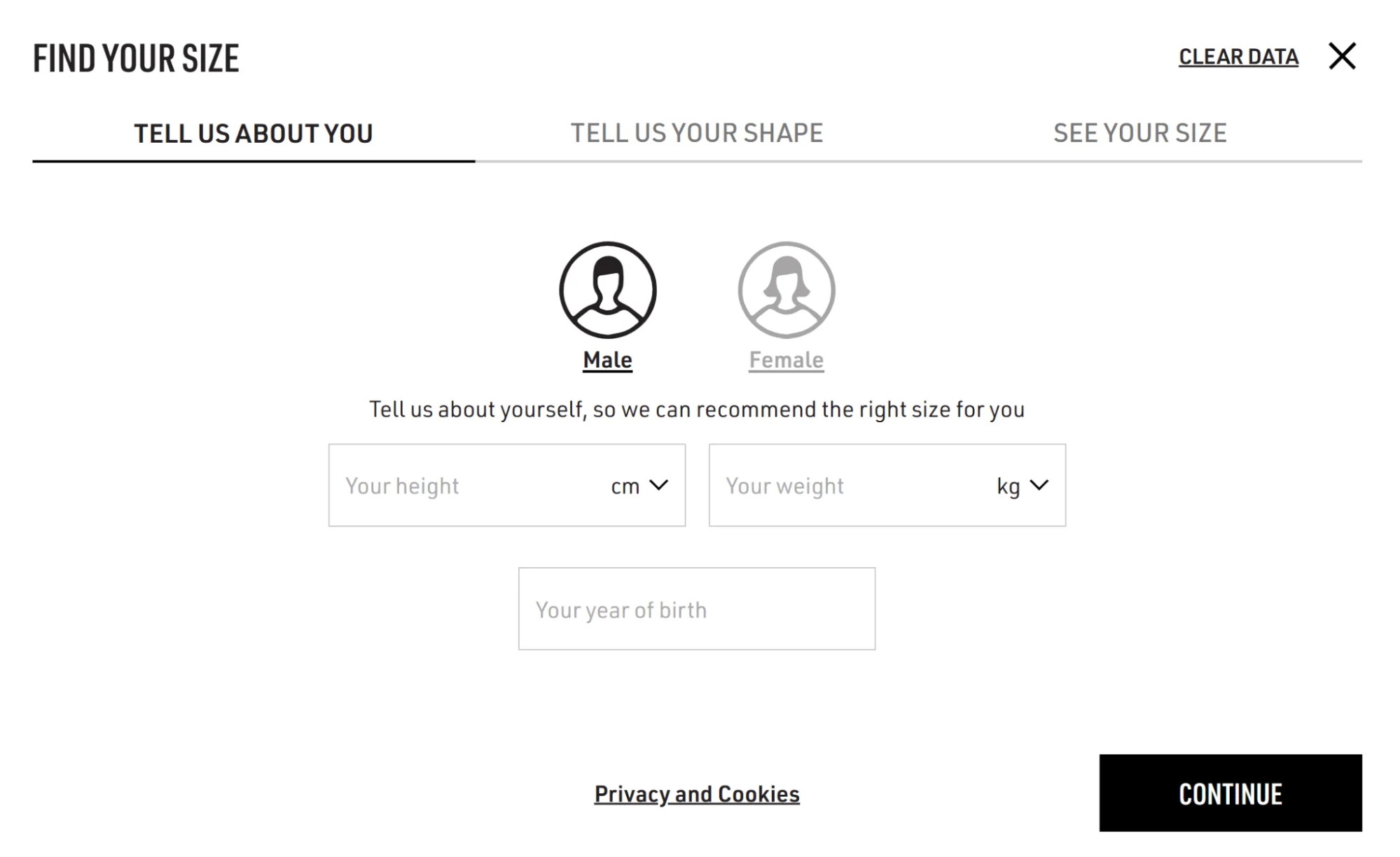
Once a shopper completes the size quiz, GG retains the data and automatically shows recommended sizes. This way, Golden Goose’s size personalization encourages customers to order with confidence.
Pro Tips:
Personalization on eCommerce stores needs to go beyond product recommendations – they need to adapt to the likelihood of purchase.
This is exactly what Eye Buy Direct does by offering real-time personalized rewards on the cart page to shoppers who are less likely to complete a purchase:
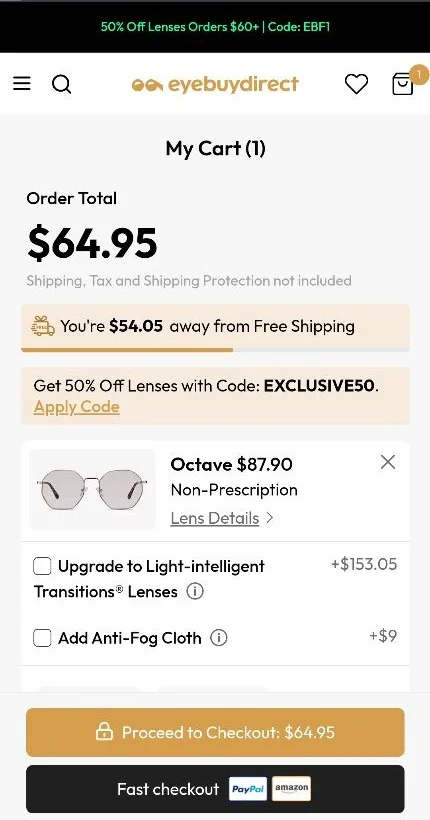
A great example of personalization on mobile, this cart page personalization technique makes use of machine learning to predict which customers are price-sensitive vs. premium-oriented. As a result, there are both options on offer.
Note how there are optional upgrades as well as a dynamic free shipping bar – and a one-tap option to apply the discount code (but note how there’s already a discount applied).
Pro Tip: Use this personalization example on your eCommerce store to offer personalized deals by willingness to pay. For example, if you’re an electronics store, offer a free warranty to shoppers who’ve browsed your sale or policy pages, but offer accessory bundles and loyalty points to returning shoppers.
Bloomingdale’s product page shows that on-site personalization is just making sure the shopping experience remains consistent. Be it auto-applying discounts to making astute recommendations:
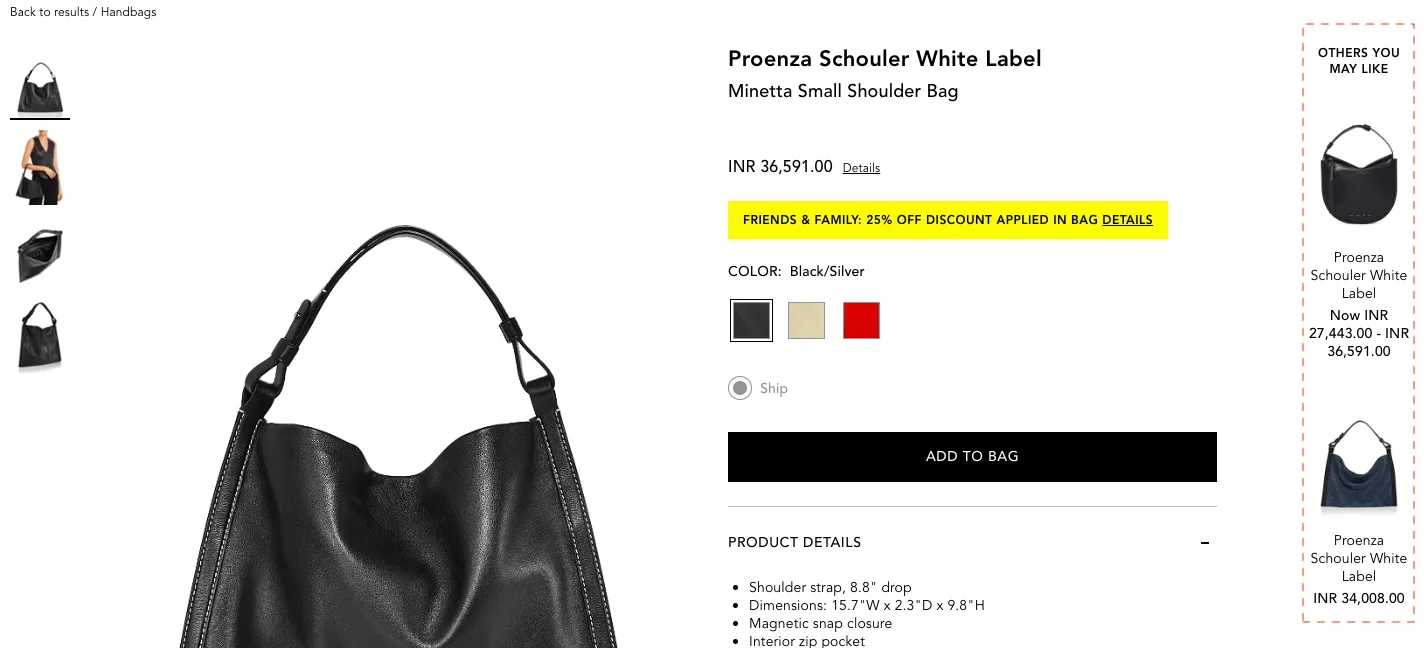
Pro Tip: Feature microcopy in your product page to nudge shoppers to sign in – take how Bloomingdale’s features microcopy to nudge shoppers to take advantage of their loyalty program and sign up, to get free shipping, free returns, and loyalty rewards:

If you’ve wondered how deep eCommerce personalization can truly go, this personalization example from Sephora, showing their Beauty Insider community, is the one to refer to.
Why do we love this personalization example so much? Well, for starters, it’s how loyalty gets gamified – note how the search bar not only lets shoppers filter through queries but also shows social proof (in terms of people available):

Then, take note of the “trending” sections that show what and who’s popular!
Pro Tip: Always use autofill to personalize your eCommerce experience for shoppers – Sephora does this within their community posts – this way, shoppers can discover new queries and new applications with ready answers:

Why make shoppers scroll through 20 recommendations? Instead, inspire them by taking a page out of Louis Vuitton’s personalization example – they show shoppers an entire curated look, along with shoppable products:
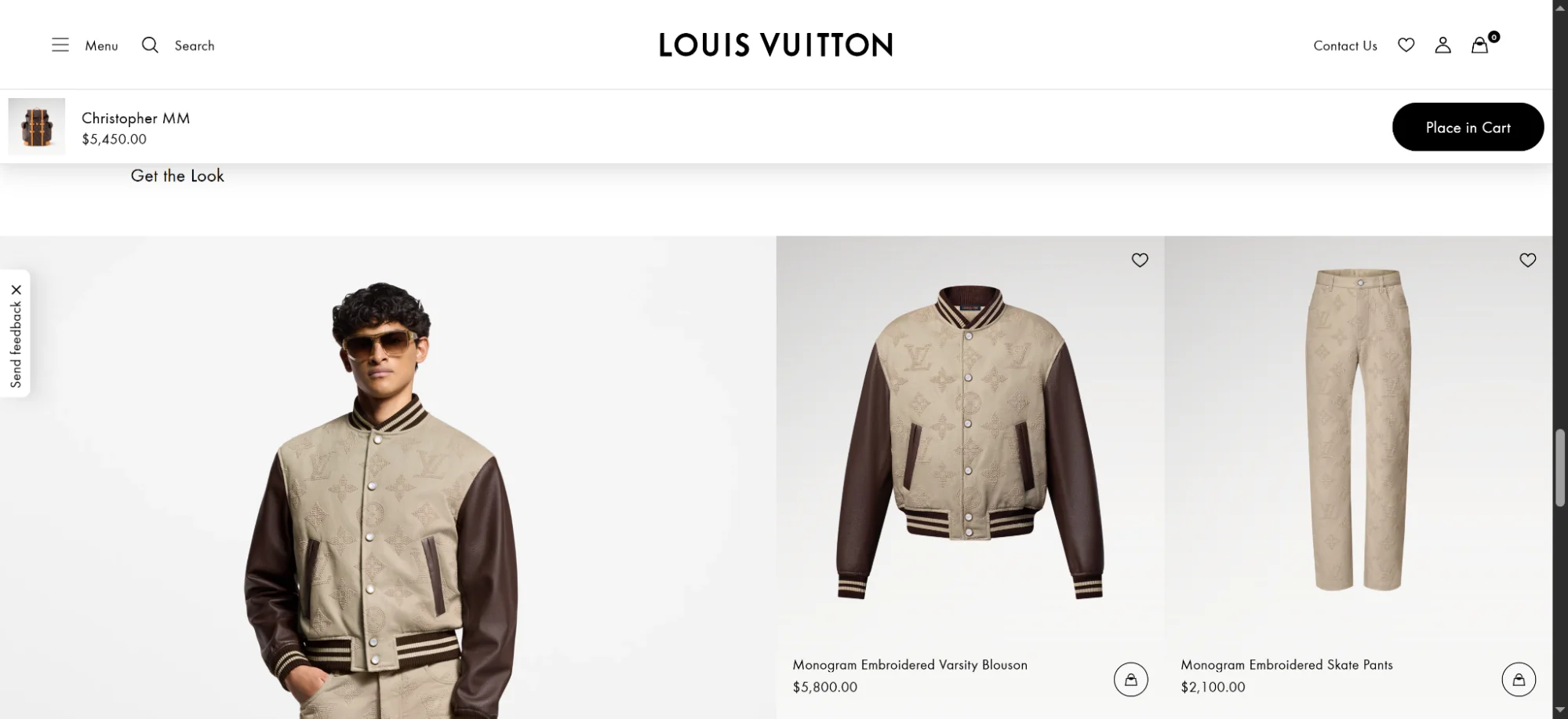
This way, cross-sells seem natural, allowing you to even offer a curated bundle – for shoppers who don’t convert.
Pro Tip: You can apply a version of this personalization technique within your product listing pages as well – for example, you can offer a call-to-action button like “shop similar” or “shop the look” to expand into more product listings based on a product’s attributes – or offer ‘frequently bought’ bundles.
Can you automatically increase AOV by personalizing offers? The answer is yes – see how Lume Deodorant personalizes their checkout by offering a mystery item for $5 (which is exactly how much is needed to get another free product from Lume):

Lume reduces friction on checkout. Instead of asking them to hunt for a $5 add-on, they put it right where the shopper can see it (as opposed to searching for one). Since $5 is only about 10% of the cart value, it feels like a fair deal. Plus, the ‘mystery’ acts as an incentive, all of which helps improve the personalization on offer.
Pro Tip: When personalizing offers for cart recovery or boosting AOV, base them on how much the shopper already knows about your products. If they haven’t browsed much, keep it broad and playful (like a mystery offer). If they’ve explored several products, give them direct, specific recommendations.
If you’re looking for answers on how to personalize mobile eCommerce – this is the personalization example you’ve been looking for. Note how the checkout fetches addresses based on the web browser’s location and autofills data:
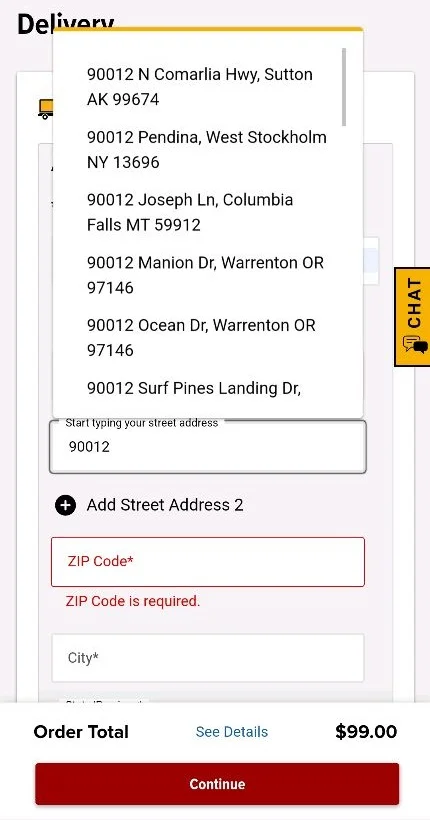
This way, shoppers spend less time typing, and it also helps you reduce errors at checkout.
Pro Tip: Some other ways to personalize your shopping experience for mobile shoppers:
Also read: eCommerce Mobile UX: 27 Ways to Get More Conversions
As we’ve mentioned before, the biggest conversion blocker during online shopping is the lack of haptics (touch and feel). Uniqlo navigates around this, with interactive images that not only let shoppers view all angles of a product up close, but also in extreme detail:
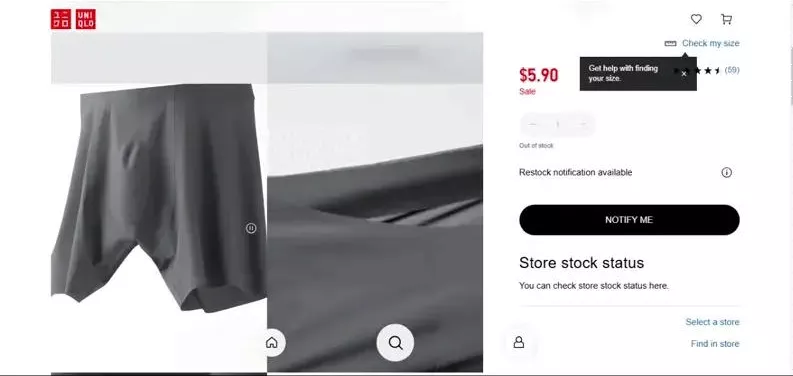
However, that’s not where they stop; they keep their product detail page high on serviceability – note how the page offers help on sizing as well as checking stock in nearby stores, when a particular product is out of stock, online. This leads us to another awesome eCommerce personalization example 👇
Most eCommerce stores would lose a sale with an out-of-stock product.
Nasty Gal wouldn’t – here’s why: they show personalized product recommendations on out-of-stock product pages:

Nasty Gal shows recommendations within the same categories (satin dresses) – as a result, customers don’t bounce off the product page immediately.
Another thing to note here is the price anchoring to show the discounted pricing of the recommended dresses.
Pro Tip: Use the first fold to show the recommendations – try building some color contrast to lead the eyes toward the recommendations.
Convertcart Pro Tip 🚀
Once your product sells out, consider reverting the price to the MRP – this ensures that users don’t see a sale price that hurts your profit margin (or worse).
Shoppers can get anxious once they reach checkout – take inspiration from how Shein personalizes the checkout process by showing nudges for the stock level (and how the order includes free on-time delivery as a service):
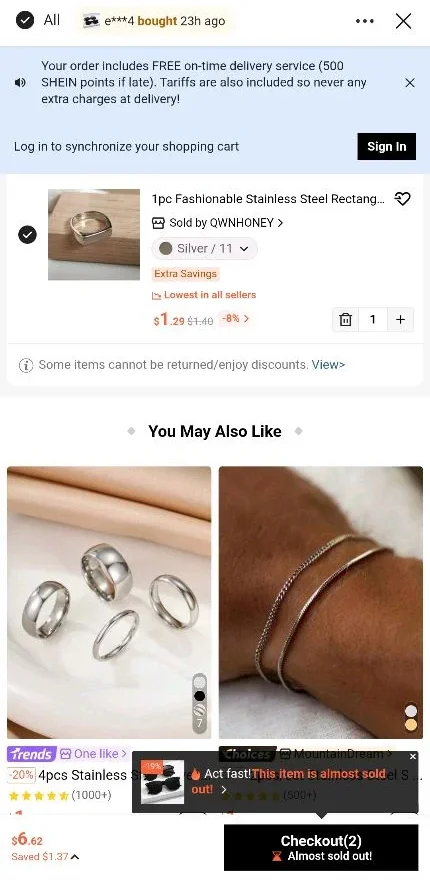
Note how the checkout CTA also displays the stock level to motivate the shopper to take action.
Pro Tip: Use this personalization tactic to offer personalized returns & exchanges – for example, you can reframe the messaging for frequent returners as “Want to try Size 9.5? Ships free tomorrow.”
This is the simplest yet the most personalized experience you can offer as an eCommerce store – all you have to do is ensure the correct user-tagged social media posts show the product in question, under the product description – as Mejuri does:

They not only show real examples of Instagram shoppers wearing the particular product but also ensure that the actual people and any other products are tagged. The best part is that this tactic adds a personal (and relatable) touch to its social proof and appreciation to its customers.
Pro Tip: Also, ensure you personalize your reviews by showing popular themes as searchable keywords – here’s a great example of this personalization in action:

If you deliver to multiple locations worldwide, like Nike does, this personalization example is for you. Not only does Nike have visually distinct homepages for their UK and US sites, but the content on recommendations differs, too.
Note how the UK site shows ranges tailored to Great Britain’s obsession with soccer and shows Rihanna wearing their latest global launch:

While the US site features a sticky navigation, all while showing ranges catering to basketball and running:
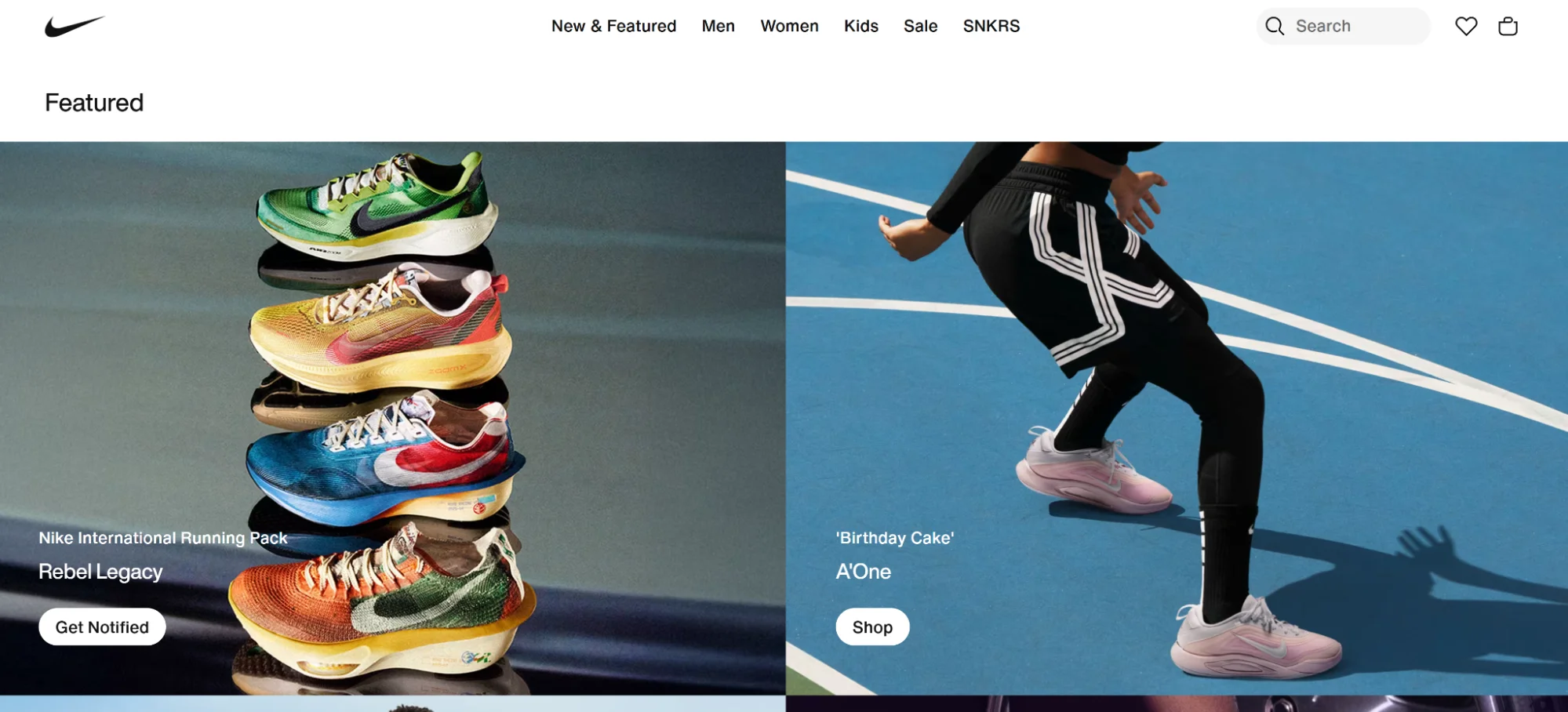
Pro Tip: You can use this eCommerce personalization technique to tie offers to cultural moments – remember: personalization isn’t just about changing the currency and language, it’s about localization too.
Apart from location, you can also hyper personalize by weather as well – note how North Face’s US site, where the weather is a bit warm (but rainy), shows rain gear as well as gear for the warmer weather:
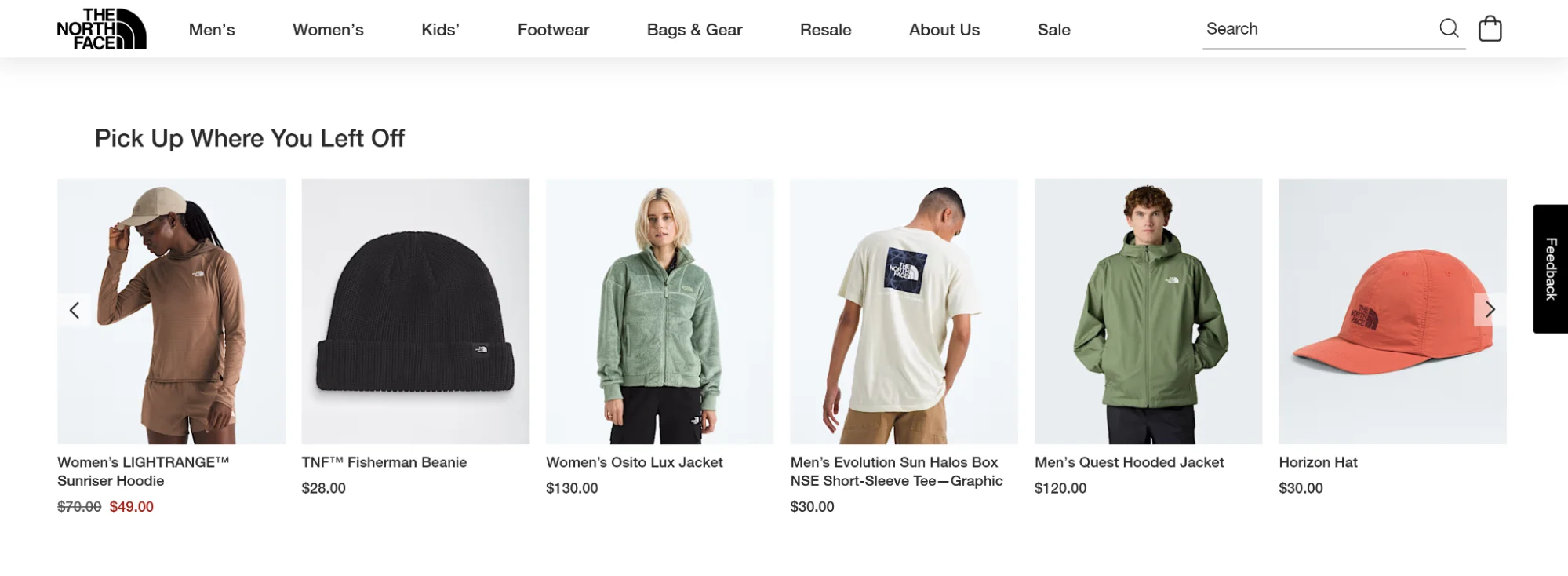
While the Canada site shows recommendations in CAD, it’s also tailored to the outright cold weather in Canada:

Pro Tip: If you run this personalization, make sure it shows personalized recommendations on PLP pages, product detail pages, and beyond.
If you’ve ever wondered, if a shoe fits your feet, you’ll know why this part is important — British Customs remembers customer choices in terms of motorcycle make and model:

You can apply this as well in terms of remembering relevant customer attributes like:
✔ hair color
✔ body type
✔ dietary choices, etc.
Pro Tip: The easiest way to implement this is by using first-party cookies and reminding users that you’ll be using cookies to personalize their shopping.
Autozone is an automotive eCommerce brand that shows another awesome use of geolocation personalization to show stock in real time:

This eCommerce personalization works because the products in question are time-bound and need-based – which means customers will want to drive and pick up.
This is why Autozone shows store timings, addresses, and contact deets—and amps the urgency up with “1 in stock.”
eCommerce quizzes are the most common form of eCommerce personalization around the world.
However, they need to be useful – Olay features a product finder quiz in the navigation menu:

Using this quiz loads up readymade solutions that users can explore. However, Olay does offer a deeper solution in the form of a 'Skincare Quiz' that digs deeper into the customer’s concerns.
Pro Tip: Use a quiz in your welcome email drip to help create better customer profiles and improve recommendations.
Also read: 13 Incredible Examples of Welcome Emails (eCommerce)
A live chat or a chatbot is where personalization mixes with support to bring the feel of a physical store.
Otter takes it a step further and offers customers an option to chat with experts who are customers themselves:

51% of shoppers want to be talked to when buying for the first time — and your live chat is THE tool to provide support and recommendations a customer deserves.
Pro Tip: Ensure your customers don’t have to explain everything from Step 1 on Live Chat – ensure that the chat agent is aware of the interactions made before the chat was initiated (also make sure they can choose the language).
Don't forget to read: Mastering eCommerce Reporting: Key Reports To Monitor
Amazon may not be great for its UX but its eCommerce personalization is on another universe.
Amazon offers personalized product recommendations even if a consumer is a first-time visitor or has been shopping with Amazon for years.
For new website visitors, Amazon has sections like “Products you’ll like” and “Most people bought” to show popular location-based products, new products, and products on sale.
Meanwhile, returning shoppers will see sections like “Pick up where you left off” or “Gift ideas inspired by your shopping history” to handle browse abandonment within the website:

Amazon knows a customer will be far more likely to make a sale when they recommend these products a customer has already browsed (especially if they have viewed more than 4 products in one category).
Pro Tip: Make sure you follow up with the same recommendations on email/SMS/medium of consent as well – start sending reminders only after 24 hours – this will help them continue shopping.
Related post: 11 Secrets behind Amazon’s high-converting product comparison charts
Customized product search results are based on a customer’s past purchase history and browsing behavior.
This helps create a tailored shopping experience that helps customers find the products they’re most likely interested in.
This makes the process quicker and easier for customers, which helps to increase conversion rates—check how Sam’s Club does it:

Pro Tip: Consider showing ‘trending searches’ to help with product discovery – this helps you show off any running sales or product launch landing pages.
Do check out: 33 Scientific Ways To Improve eCommerce Product Discovery
eCommerce personalization is about understanding and tuning to the needs of your shopper – Babyganic does the same with well-categorized navigation with product recommendations:

Babyganic knows that shoppers are browsing for products on their navigation—they simply cut the cognitive load by showing the most bought/browsed products on the navigation itself.
As far as eCommerce personalization techniques go, this one’s extremely smart 🧠—California Baby pairs persuasion with social proof and personalization:

Discounts are already enticing – the special sauce here is the discounted bundle of ‘often bought together’ products – for example, the diaper rash ointment + calming wash + powder is a no-nonsense combo.
Pro Tip: Consider adding a countdown timer on the bundle discount to amp up the urgency—say something like “Snag it for FLAT $X OFF before XX:XX:XX.”
Petco uses information from its customers’ previous purchases and account information to provide relevant, personalized product replenishment recommendations with personalized pricing.
For instance, a customer who has viewed/purchased puppy products might receive a discounted product recommendation like the one shown below when they visit Petco’s homepage:

Petco’s recommendations help customers as they match browsing history with order histories of the individual customer and other customers with puppers – here’s how they arrive at the recommendations:
Pro Tip: Try sending reminders for replenishment based on a customer’s previous purchase history and product shelf life – show the price difference and the savings to further the effectiveness of the personalized pricing.
Related post: 17 retention strategies that actually work (for eCommerce)
Personalization on mobile = great mobile UX?
Yes – with a touch of conversational elements.
Check how Knix here offers a recommended product on SMS by browsing and purchasing history:

Pro Tip: Try maintaining an omnichannel approach – send similar messaging on targeted email and segmented push notifications – but, time them apart (say 1 day apart).
By grouping customers into segments, you can deliver targeted content and product recommendations that are more likely to be relevant and appeal to them.
That’s exactly what Fashion Nova aims to do here with their opt-in form:

They can then use this data to develop strategic communication channels as well as engagement programs to build deeper relationships with customers and keep them coming back.
Pro Tip: Experiment with your CTA as much as you can for better personalization and framing—note how the CTA goes into the first-person mode with “I love saving money.”
Adidas is a great eCommerce personalization example to show personalized birthday emails and product recommendations:

Birthdays are a big deal! Show your customers that you value them by not only sending them an email on their birthday but also sharing product ideas that they might like.
Pro Tips:
You might also like: 17 Top eCommerce Mobile Site Examples (Not Your Usual Brands)
Hobbycraft takes product recommendations a step further than most by showing recommended DIY projects consumers should try based on the specific products a customer is viewing on Hobbycraft:

Customers are able to see completed projects made by Hobbycraft experts. This use of social proof combined with eCommerce personalization will encourage shoppers to buy the rest of the tools they need in order to start working on a project of their own.
Pro Tip: Another alternative to this is shoppable live streams or videos – invite shoppers who’ve viewed certain products to watch you show a “how-to” – this opens up a 1:1 channel on comments – with which you can fully personalize their experience.
Also read: Why is my conversion rate dropping? And how to fix it
Like Netflix uses personalization to encourage shoppers to return to its website and watch new movies and shows, Baby Bjorn offers personalized customizable carriers for your little one:

Letting users customize an entire baby carrier to their liking taps into the endowment effect (makes customers feel connected to something they’ve built and IS theirs).
Pro Tip: Make sure you don’t offer way too many recommendations—which can lead to choice paralysis – limit to a maximum of 4 recommendations at a time.
Soliciting personal preferences is a great form of eCommerce email personalization – and, as an eCommerce business, this will let you segment properly and send personalized advertisements, product recommendations, and discounts.
Wantable has an option for email subscribers to update their preferences—this way, they can receive targeted product recommendations for their specific choices:

Other than that, they also sneak in the announcement of their new collection launch (which is also a great way to generate hype for new products).
Pro Tip: Keep asking for likes, dislikes, and other information from your customers—note how Wantable does the same (check above the “Update my Quiz” CTA button).
The gifting season is a tough time for all – Nordstrom personalizes the experience with segmentation and customer profiles by creating a gift guide for all kinds of products, receivers, occasions, and budgets:

Boost sales during holiday seasons by using this approach to send personal gift recommendations to your email subscribers based on their search history and the product pages they have viewed on your website.
Pro Tip: Tie in your loyalty program as well, along with the gift guides—doing this helps your customers feel connected to your brand and find value in being a customer.
What’s personalization without retargeting? Adidas takes this personalized ad approach to retarget cart abandoners on Facebook:

Adidas uses a friendly yet not too strong push to check out the cart—note how they use “psst” and “your cart”. Doing this helps you remain on their minds and shows you care enough to remember them with an aura of exclusivity.
Pro Tip: You can also use this personalization technique to bring back shoppers to a back-in-stock product—specifically target shoppers who viewed a sold-out product.
Convertcart Pro Tip 🚀
This technique uses dynamic products to retarget visitors – ensure your tracking tags are properly recording events. Furthermore, use custom audiences for retargeting – retain them for 30 days from the date of the first visit:

Don't forget to check this out: Hiring a CRO agency: 12 *Key* Considerations (and Expert Advice)
This eCommerce personalization technique asks questions – Vevor, asks for opinions on questions like:

To do this, Vevor makes the feedback button sticky – and on standby is a “contact us” button which provides 1:1 prompt service.
When you ask for feedback from your audience, you can gain the information you need to set up your personalization eCommerce benchmarks.
Pro Tip: Consider following up with post-purchase surveys as well to provide the best possible brand experience – and remove friction in the checkout process.
Also read: Guest checkout: Still a good choice? (+ 16 way BETTER alternatives)
The usual way: You send personalized emails with a personalized discount code when someone abandons their cart or send a pop-up with a code for first-time visitors:

The Bark.co way: Offer a small discount that feels personalized for every shopper (yet doesn’t require a lot of tech):

What Bark.co does is show a simple checkbox to check and get an extra 5% off. The pre-requisite? The shopper’s dog has to be the best – with this Bark.co captures the sale and moves to the cart.
Pro Tip: If you have an active quiz funnel, personalize the messaging—like “get x% off for {dog name}” or “{customer name}, you deserve x% off.”
Do read: Top eCommerce Events in India (Updated for 2025)
eCommerce personalization is all about customizing the customer experience to make it:
– unique to each shopper
– feel personal
– deepen the relationship
Sometimes, that includes surprising the customer:

Here, Home Chef has been able to identify that this particular customer will be happy with a $10 bonus and may be encouraged to keep browsing or even check out.
Pro Tip: Segment your list by spending capacity and invite top spenders to collaborate with you on a product launch or some form of access to brand elements (like naming, packaging, etc.)that no other customer would have access to.
What we already know: Personalization is a great way to tailor email marketing campaigns.
What it takes to make personalization work:
✔ The right offers
✔ The right kind of recommendations
✔ The right amount of detailing
This is exactly what Skechers does with their personalized cart abandonment email:

Skechers uses dynamic content in their email to add to the personalization – note the size, color, and recommendations.
Is that all? The offers, too, are targeted for loyalty program members, which, of course, adds incentives and encourages customers to come back and complete the purchase.
Pro Tip: You can use this email personalization to send email reminders about the expiry of a custom discount code, offered during opt-in or any other custom email drip. Take a look at the example below for more inspiration 👇
Related posts:
i. 10 Questions to Ask When Hiring An eCommerce Email Marketing Agency
ii. High-Converting Abandoned Cart Email Examples
Most eCommerce personalization techniques recommend offering discounts—but, do you want your best customer to spend less?
Quill knows how to keep the purchases going—with a reminder email to cash in loyalty points for a product:

The fun part starts here: the free gift on offer is a salt lamp.
However, with greater points comes a greater reward with significant value — note the portable air conditioner fan (also note the decoy effect in play).
Also read: Simplify online shopping for senior citizens: 16 UX ideas
While there are countless reasons why eCommerce personalization is a must, there are three benefits that you should make sure you consider:
✅eCommerce personalization helps retain existing customers
✅ eCommerce personalization helps turn new customers into lifelong customers
✅ eCommerce personalization helps boost conversion rates
It’s the number one way for you to grow your business is to foster lifelong customers. According to Invesp, it costs 5x as much money to acquire a new customer as it does to keep an existing one.
Furthermore, existing customers spend 31% more than new customers, and are far more likely to make a purchase from your website. The data is abundantly clear- retaining customers is essential.
Personalization is useful for every kind of visitor or customer—it also:
✔ brings the best possible shopping experience when they visit your website
✔ shows returning visitors products aligned with their interests/searches
✔ reduces the frustration of clicking through multiple pages
✔ reassures that the brand cares about the shopping experience and overall satisfaction
✔ makes visitors/customers feel in place and makes them more likely to add to their online shopping cart
In fact, according to research from Epsilon, 80% of consumers are more likely to make a purchase from a business that offers a personalized shopping experience.
What are some benefits of eCommerce personalization?
Here are a few examples of eCommerce personalization:
a. Recommend products based on past behavior
If a shopper has purchased a certain type of product in the past, it’s likely they’ll be interested in purchasing similar products in the future. By recommending products based on past behavior, retailers can increase sales and conversion rates.
b. Show relevant products based on the current location
If a shopper is searching for a product on a retailer’s website, the retailer can show relevant products based on the shopper’s current location
c. Personalize the checkout process
There are a few different ways to personalize the checkout process. One way is to offer a discount to shoppers who complete the checkout process. Another way is to offer a free shipping option for shoppers who complete the checkout process.
d. Send personalized email campaigns
Email is one of the most important channels for eCommerce retailers.
One of the best ways to personalize the eCommerce experience is through product recommendations.
Product recommendations are based on a customer's previous purchase history, browsing behavior, and other data points. This means you have to have data collection set up when developing your eCommerce store.
Personalized product recommendations are one way to increase customer engagement and conversions on your eCommerce site.
Research shows businesses lose $756 billion due to lack of trust and poor personalization.
Let's take a look at some stats:
Through personalization, eCommerce businesses see:
There are many ways for you to gather the information you need in order to use personalization in these ways
Surveys are an explicit way to garner this important information. These tools allow your website visitors and email subscribers to answer specific questions so that you can segment them and provide them with relevant product recommendations and offers.
Take this survey request that MeUndies emailed to its previous customers for example:

You can take personalization a step further when you use surveys by offering a personalized discount in exchange for the consumers’ time and energy.
For example: Does a customer typically buy a specific brand of pet food?
Try offering them 10% off of their next bag if they complete a survey for you. This personalized offer will increase the likelihood that the customer will take the survey – and you’ll have useful data to help market to them in the future.
eCommerce personalization ideas can help increase the conversion rate and customer retention of several ecommerce businesses spanning a variety of industries:
Customer accounts are a great tool to see which products are popular. Take a look products in wish lists and save for later elements. Being able to save products for later is a big deal.
It's all about lending convenience to customers.
Customer experience aside, eCommerce businesses have the opportunity to learn through these tools what types of products their customers like the most. This data could be used in deciding what products to promote through sales, email newsletters, and other means.
98% of visitors who visit an eCommerce site—drop off without buying anything.
Why: user experience issues that cause friction for visitors.
And this is the problem Convertcart solves.
We've helped 500+ eCommerce stores (in the US) improve user experience—and 2X their conversions.
How we can help you:
Our conversion experts can audit your site—identify UX issues, and suggest changes to improve conversions.